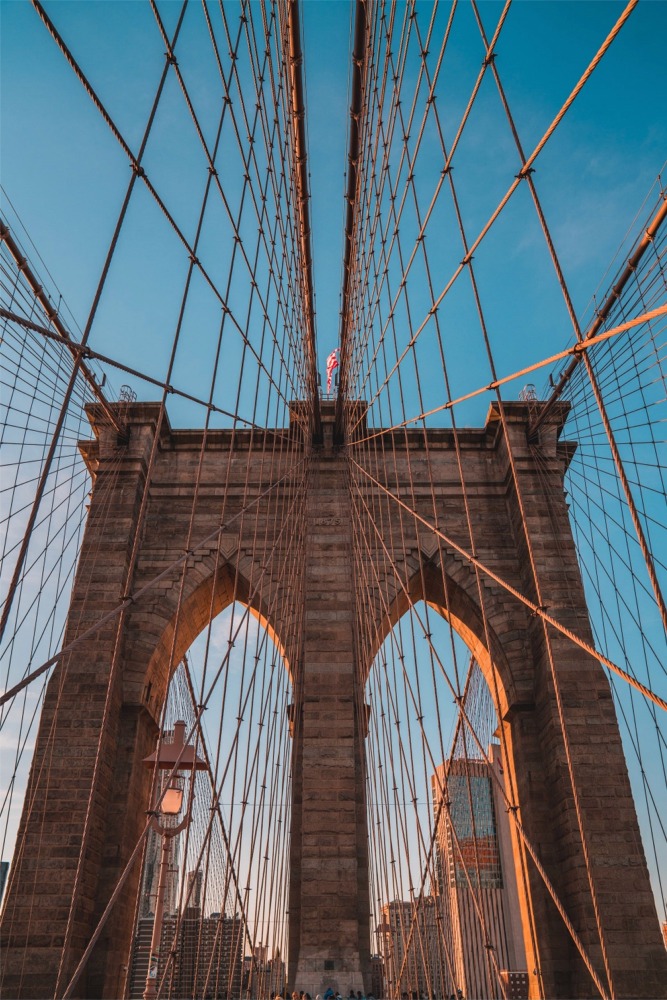Brooklyn Bridge West Pier
Home > New York State Photographs > New York > Brooklyn Bridge West Pier

The day was drawing to a close, and the sky above Manhattan had transformed from a tranquil aquamarine blue to an incandescent pink. The sun was beginning to set, and its last tendrils of light were reflecting off the West Pier of the Brooklyn Bridge — framed by its latticework of suspension cables that held the bridge steady. As the last slivers of the sun fell behind the horizon, the West Pier was backlit in shadow, yet the two arches brilliantly caught the last of the daylight, casting a burning fire in the sky for the pedestrians below. Above the grandeur of the West Pier was the great American flag, its stripes and stars aflame in the light of the setting sun. One could almost feel the power of the flag as it fluttered in the wind, a symbol of a nation rising towards the future.
The setting of the sun marked the end of another day of hustle and bustle in New York City. The streets were now empty, and the only reminder of the day's events was the ringing of the bell from the nearby carousel. As it slowly began to fade away, the West Pier remained a majestic sight in the evening sky, beckoning to those below to marvel at the beauty of the moment.
Brooklyn Bridge
The Brooklyn Bridge is an iconic landmark that spans the East River, connecting the boroughs of Manhattan and Brooklyn in New York City. It is one of the oldest suspension bridges in the United States and has become a symbol of the city's engineering prowess and architectural beauty. Here's some information about the Brooklyn Bridge:
Construction
The construction of the Brooklyn Bridge began in 1869 and was completed in 1883. It was designed by the architect John A. Roebling, with assistance from his son Washington Roebling and his son's wife Emily Warren Roebling. The bridge's construction faced various challenges, including the use of caissons (large watertight chambers) for the bridge's foundations and the implementation of steel cable suspension technology.
Architecture and Design
The Brooklyn Bridge showcases a combination of Gothic and neo-Gothic architectural styles. It features two towers made of granite, limestone, and cement, connected by steel cables and suspension cables. The bridge has a total length of approximately 6,016 feet (1,834 meters) and a main span of 1,595.5 feet (486.3 meters), making it an impressive engineering feat of its time.
Function and Transportation
The Brooklyn Bridge serves as a vital transportation link between Manhattan and Brooklyn. It carries vehicular traffic, pedestrians, and cyclists. The bridge has two designated roadways for vehicles running in either direction, as well as an elevated walkway for pedestrians. It offers stunning views of the Manhattan skyline, the East River, and the surrounding areas.
Landmark and Symbolism
The Brooklyn Bridge is recognized as a National Historic Landmark and has immense cultural significance. It represents the ingenuity and progress of New York City and has been featured in numerous films, literature, and artworks. The bridge is often associated with the American Dream and serves as a symbol of unity and connectivity.
Pedestrian Experience
Walking across the Brooklyn Bridge is a popular activity for both locals and tourists. The elevated walkway provides pedestrians with a scenic pathway to enjoy panoramic views of the city. Along the way, there are historical plaques and benches where visitors can rest and take in the surroundings.
Cultural and Social Importance
The Brooklyn Bridge has played a significant role in shaping the cultural fabric of New York City. It has inspired artists, writers, and photographers who have captured its grandeur and significance. The bridge has also been a site for public gatherings, celebrations, and demonstrations, reflecting its role as a symbol of civic pride and resilience.
The Brooklyn Bridge stands as an iconic landmark, a testament to human engineering and a cherished part of New York City's history. It continues to captivate and inspire people from around the world, attracting millions of visitors who come to admire its beauty and experience its unique charm.


